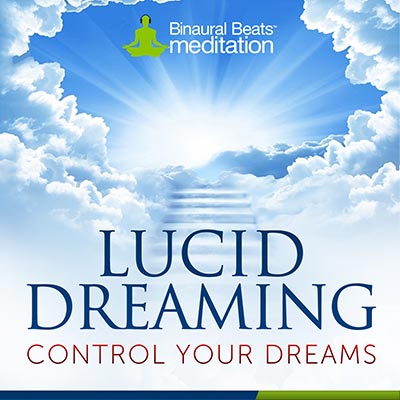Lucid dreaming typically happens during the dream stage of sleep, known as REM (rapid eye movement) sleep. Lucid dreaming is possible for everyone but isn't easy to achieve.
However, there are a number of techniques, including listening to binaural beats music as an aid, that experienced dreamers use to help them maintain awareness and control.
In this post, we will discuss some of these techniques and assist you on your quest to control your dreams.

What is a Lucid Dream?
During a lucid dream, you’re aware of your consciousness; you have an awareness of your awareness, so to speak.
Lucid dreaming also lets you control what happens in your dream.
Most people will experience a lucid dream in their lifetime, but some people experience them more often than others.
Indeed, according to a meta-analysis, estimated 55 percent of people have had one or more lucid dreams in their lifetime – so if you haven't had one yet, you have more than a 1 in 2 chance.
Despite this statistic suggesting that a large number of people have experienced a lucid dream, most people struggle to induce one of their own.
If you've ever been dreaming and, within that dream, felt the sensation of the same consciousness you have when you are awake, then you have most likely experience a lucid dream.
It is a form of metacognition, which is critical awareness of one's thoughts and consciousness; like thinking about thinking.
In a lucid dreaming episode you may find yourself in a strange situation or environment, whereby you are aware that it is strange.
Perhaps you are with someone or more than one person you know, or someone you know you couldn't possibly be with.
This is unlike a normal dream, because in a normal dream you generally don't realize how strange it was until you are awake.
In the lucid dream, you stop to question the reality of the experience and then realize you are dreaming but with awareness.
From this point in, you may be able to control aspects of the dream, so that it becomes like a real-world experience.
It is extremely exciting, because your dream becomes like a virtual reality game, where you can choose the narrative.
Lucid Dreaming Misconceptions
You Must Be in Control
One misconception about lucid dreaming is that a dream isn't lucid unless you can control it.
This is not true and there is a fair amount of confusion between dream control and dream lucidity. They are akin to each other but you can have one without experiencing the other.
An example of this is that the majority of dreamers are able to elicit no control over their dreams, lucid or otherwise.
Other people can actually control their dreams and yet not be aware that they are actually dreaming. In the dream the dreamer believes that they are controlling everything – that they have a godlike power. This demonstrates then, that dream control can be conscious or unconscious.
Only for Spiritual People
Another misconception about lucid dreaming is that ‘new age types’ or the more spiritual among us are more likely to experience one. This is not the case.
There is evidence that people have experienced lucid dreaming over thousands of years and they have come from all or no religion.
Lucid dreaming can affect anyone, anywhere of any background.
Just a Form of Escapism
Some postulate that lucid dreaming is for those seeking to escape life itself.
This is no truer than for those playing a computer game or reading a fictional book.
Lucid dreaming happens when you are asleep, so it does not impact on how you interact with the real world.
Some lucid dreamers do like to write down their dreams or discuss them with others, and some people even like to plan lucid dreams, inducing them using aids such as binaural beats, which we'll discuss below.
But this does not prevent a person living in the reality of the real world.
If anything, being excited about dreaming can improve and enhance the enjoyment of your sleep. Moreover, you cannot sleep indefinitely, and you will have to awake to the real world.
Dark & Unnatural
For some religious or spiritual groups, lucid dreaming has been labelled as inherently ‘dark or ‘unnatural’.
This is certainly not the case.
Lucid dreaming is not linked to the occult or any other spiritual practice, although many lucid dreams have been the conduit of religious epiphanies and messages, in the same way that artistic masterpieces or great works of literature have come about.
Our dreams are an extension of us; they are what we make of them.
Climbing the Levels of Lucidity
Lucid dreaming sounds exciting and it's natural to want to jump in and get started. The thing is, it takes time to have a lucid dream and to achieve a high level of lucidity.
Additionally, levels of awareness of lucid dreams naturally vary between people, but also within the individual too.
If your level of lucidity is high then you will be very aware that what you are experiencing within the dream is not real, and therefore you will know that you have nothing to be afraid of.
However with a low-level lucidity you are only partially aware that you are in a dream. In this situation you are not aware enough to make any changes to the dream, and you may accept things that you would normally question in your daily reality.
Low-level lucidity can mean that the realization that you are in a dream quickly fades, and then the dream seems real.
The more you practice and the more you tap into this innate ability, the more aware and the more control you will gain.
How to Have a Lucid Dream
Technique 1: Wake Back to Bed (WBTB)
The most popular technique and the one we recommend is the Wake Back to Bed (WBTB) technique.
There are variations of this technique but we develop this particular version.
- Set an alarm for a couple of hours before you normally wake up.
- Go to sleep as normal.
- When the alarm goes off, you will want to stay awake for approximately 20 minutes.
- To stay awake, go to the toilet if you need to, and have some water.
- Settle back into bed and put your headphones on and begin listening to our binaural beats Lucid Dreaming track.
- The track will guide you back towards sleep but help you enter the hybrid state of consciousness that enables the lucid dream.
Our track helps you achieve this state by encouraging the brain to produce low Theta waves, and then high Delta waves, that prevent you from falling into a deep sleep and keep you hovering in the zone of light sleep (REM sleep, stages 1 and 2).
This is important, because according to according to a study in PLoS One, the chances of lucid dreaming depends on the level of alertness of the brain.
Technique 2: Lucid Afternoon Nap
Alternatively, you can try lucid dreaming using the track when you have an afternoon nap.
For some people this works better, because a nap in the afternoon tends to be, by nature of the brain state, a light sleep in which you are recharging your mind and body but with a level of awareness of what is going on around you and the fact that you are napping.
- Take your nap by laying on the sofa or the floor
- Put on your headphones and press play on the track. Use the 30-minute version for this purpose, as naps tend to be fairly short in duration.
- Allow yourself to fall into the nap-state as you normally would
How Binaural Beats Can Assist Lucid Dreaming
To induce a lucid dream, where you have control and awareness over your dream, it is best to gradually slow your brainwaves down into deep relaxation rather than fall asleep quickly.
This is a problem area for most suggested techniques, such as the Wake Back to Bed. Most people find they simply fall straight back to sleep and into a deep dream that they don't recall or have the ability to control any aspects of.
Our Lucid Dreaming track uses Theta frequencies to guide you into a deeply relaxed state. The music then slowly drops down into the Delta zone, enabling you to fall into a light sleep.
This keeps you in limbo, in a cat-nap-like sleep state where you are almost asleep and able to dream lightly but would be woken if someone made a loud noise or called your name.
In this state, your subconscious mind will awaken but leave your conscious mind asleep. This is a mind trick of sorts, because your subconscious will assume you are awake and therefore give you control of your dreams.
Additional Training Techniques
MILD – Mnemonic Induction to Lucid Dreaming
You may have heard about the MILD technique, as “experts” commonly cite it. Psychophysiologist Dr. Stephen LaBerge, a pioneer of lucid dreaming research, created it in 1980.
MILD is based on a behavior called prospective memory, which involves setting an intention to do something later.
In this case, you think of a recent dream while you fall asleep. Think about returning to that dream and recite the phrase “The next time I dream, I want to remember that I am dreaming.”
You can incorporate this with our techniques about to improve your chances of a dream.
You can also practice MILD after waking up in the middle of dream. This is the perfect time to do this, as the dream will be fresh in your mind and you will remember the details.
Think about the dream as you fall back to sleep. Identify an aspect of the dream that you know can only occur in a dream, such as the ability to fly.
Focus on this while repeating the aforementioned phrase.
Reality Testing
A 2017 study published in the journal Dreaming documented that a combination of reality testing, our Wake Back to Bed technique and MILD works best for those attempting to lucid dream.
Reality testing is a form of mental training that improves your awareness.
Your metacognition is similar in your waking and dreaming states, so improving awareness when awake could promote higher metacognition when you’re dreaming.
To practice reality testing, go through these steps several times a day:
- Stop and ask yourself, “Am I dreaming?”
- Check your environment by touching something to confirm whether or not you are dreaming.
- Notice your surroundings; the people, the trees, the cars, the sky; does it look normal to you.
This sounds very simplistic, by the idea is that through repetition you will gain the skill to do this when you dream and be able to recognize when you are in the dreamworld.
How to Wake Up from a Lucid Dream
Some people worry that if they lucid dream and they don't like the experience they won't be able to wake from the dream.
This fear is similar to that of having a nightmare, and this wouldn't be any different.
When we are having a nightmare, we usually wake ourselves at the point it becomes unbearable.
In the case of a lucid dream, you are aware and will probably have a degree of control.
So, to wake yourself up, simply do what you would do in a real-life situation.
- Shout out or scream. This will jolt you from your dream.
- Start talking continuously. This will eventually wake you up.
- Start blinking really fast. This physical action will ultimately wake you up.
- Fall asleep within the dream. Sounds crazy, right? But it's not. You are effectively awake with the dream, so by falling asleep you will change the reality.
The Benefits of Lucid Dreaming
Most of the purported benefits of lucid dreaming are anecdotal. However, in a therapy setting it is said that lucid dreaming may be able to help those having excessive nightmares, and those with PTSD.
It is also suggested that lucid dreaming may help with anxiety and motor skills.
Anxiety
Those who suffer social anxiety, or agoraphobia, for example, may be able to replicate the circumstances in which they feel anxious in their dreams. They can then face these issues in a non-real-world environment and practice coping mechanisms.
These real-life-like experiences may then translate to the real world, acting as a therapy of sorts.
Motor Skills
The same is said for the improvement of motor skills. Those will disabilities may be able to practice motor skills in their dreams in a real-life-like environment.
This may stimulate the area of the bran or body that needs rehabilitating, providing a sleep-therapy that may help in real life.
How Long Will it Take for Me to Lucid Dream?
For most people it takes a minimum of three attempts to experience even a small amount of awareness and or control in a dream. However, using our track can aid the process and considerably improve your chances.
That said, the trick is not to try and force it. Don't really try hard to have a lucid dream. Instead, as you would with meditation, let go.
Let go of wanting to have a dream and allow yourself to relax. Simply follow the steps and don't concern yourself with whether you will have one or not.
In our experience, you should continue to practice with the same process for a minimum of six weeks before trying something new.







